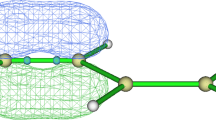Abstract.
The full configuration interaction method in the space of fractionally occupied unrestricted natural orbitals (UNO-CAS method) is extended to excited states as well as to strongly correlated and reactive systems with large active spaces. This is accomplished by␣using restricted active space (RAS) wave functions introduced by Olsen et al. [(1988) J Chem Phys 89: 2185] and using the UNOs without the expensive orbital optimization step. In RAS, the space of active orbitals is subdivided into three groups: a group with essentially doubly occupied orbitals (RAS1), the usual CAS space (RAS2), and a space with weakly occupied active orbitals (RAS3). We select these spaces on the basis of the occupation numbers of the UNOs. All possible electron distributions are allowed in the usual CAS space, but the number of vacancies is limited in RAS1 and the number of electrons is limited in RAS3. We discuss an efficient algorithm for generating a RAS wave function. This is based on the Handy-Knowles determinantal expansion with an addressing scheme adopted for the restricted expansion. Results for both ground and excited states of azulene and free base porphyrin are presented.
Similar content being viewed by others
Author information
Authors and Affiliations
Additional information
Received: 16 July 1998 / Accepted: 7 August 1998 / Published online: 19 October 1998
Rights and permissions
About this article
Cite this article
Kozlowski, P., Pulay, P. The unrestricted natural orbital-restricted active space method: methodology and implementation. Theor Chem Acc 100, 12–20 (1998). https://doi.org/10.1007/s002140050361
Issue Date:
DOI: https://doi.org/10.1007/s002140050361



